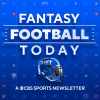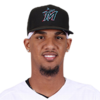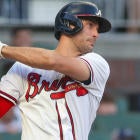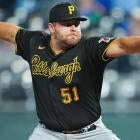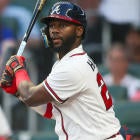
If there's one thing 2023 will be remembered for, it's the return of the stolen base. It's there's another thing 2023 will be remembered for, it's the chaos inflicted on the starting pitcher ranks.
Turns out all the rule changes worked together to create maximum pitcher torment. The shift ban meant more traffic on the bases. The pickoff limit meant more activity on the bases. The pitch clock meant no opportunity to change the tempo when things began to spiral.
And so spiral they did. As blowup starts became commonplace, even for some of the best pitchers, ERA basically lost all meaning, becoming more a reflection of how a pitcher's latest start went than anything else. That's something of an exaggeration, but it's clear there was a general flattening across the pitcher ranks, with fewer points of differentiation as predictability went on the window. Though it was always true to some degree, it became truer than ever in 2023: anything could happen to any pitcher on any given day.
Presumably, it'll get better. Pitchers will adapt to their new reality and learn to separate themselves in other ways. But until we see it happen and know what those ways are, we need to reduce our vulnerability to this new reality in Fantasy. And to that end, I say we go back to the basics and focus primarily on strikeout rate.
It's the one thing a pitcher has direct control over. Even if his world is collapsing in other ways, chances are his strikeouts will be there. Of course, it's also true that a shift ban hardly matters if the ball is never put in play, and we've long known that pitchers who miss more bats generally have higher overall outcomes. But more than anything, an emphasis on strikeouts ensures domination in one pitching category even when the others feel like a crapshoot.
So if it seems like I've upgraded or downgraded certain pitchers based solely on their strikeout potential, you can trust that it's completely intentional. Apologies to safe but relatively unspectacular pitchers who didn't make the cut as a result, such as Sonny Gray, Jordan Montgomery and Chris Bassitt.
Note that the focus here is standard 5x5 scoring (such as Rotisserie leagues), but scroll a little further and you'll see my rankings for points leagues.
| 1 |
Spencer Strider
Atlanta Braves SP
|
| If strikeouts are the biggest differentiator among starting pitchers in this environment, then No. 1 has to be Strider, who had 44 more than anyone else. Bringing his 3.86 ERA closer to his 3.09 xERA and 2.85 FIP will only put him that much further ahead. | |
| 2 |
Gerrit Cole
New York Yankees SP
|
| The K/9 and swinging-strike rates went from elite to merely above average, but even so, Cole maintained his ace standing through sheer reliability. It's possible he's beginning to decline at age 33, but his track record earns him the benefit of the doubt at a position with few sure things. | |
| 3 |
Kevin Gausman
Toronto Blue Jays SP
|
| In a year when so many of the elites saw their strikeout numbers take a turn for the ordinary, Gausman turned in eight double digit-strikeout efforts, second only to Spencer Strider. He's as durable as you could ask from a modern ace as well. | |
| 4 |
Zack Wheeler
Philadelphia Phillies SP
|
| Wheeler's 3.61 ERA was by far his highest in four seasons with the Phillies, but it was only 3.08 in the second half, which was more in line with his 3.21 xERA and 3.15 FIP. A higher ERA is forgivable in a pitching-starved environment, particularly if the source is a near certain 200-strikeout guy. | |
| 5 |
Corbin Burnes
Milwaukee Brewers SP
|
| Arguably the most dominant pitcher in 2021 and 2022, Burnes saw his strikeout rate tumble in 2023, but within the ranks of the elite, he was hardly alone in that regard. He has a better excuse than most, having struggled to reach his usual velocities early on, but he managed to keep his head above water until things normalized in the second half. | |
| 6 |
Luis Castillo
Seattle Mariners SP
|
| The Mariners have brought out the best in Castillo, who always had good strikeouts numbers with the Reds but struggled to keep men off base. He throws more strikes now but is also more home run-prone, giving him a higher xERA (3.79) and FIP (3.81) than you'd expect from an ace. | |
| 7 |
Zac Gallen
Arizona Diamondbacks SP
|
| Gallen has proven to be a workhorse and should deliver an impressive strikeout total as a result. But between his high average exit velocity and modest swinging-strike rate, he's perhaps more vulnerable to a blow-up than the six ahead of him here. | |
| 8 |
Tyler Glasnow
Tampa Bay Rays SP
|
| Glasnow may be the one who comes closest to Spencer Strider in pitch-for-pitch dominance and actually had the better xFIP (2.75) of the two in 2023. The problem -- and it's a big one -- is that his 120 innings were his most ever in eight big-league seasons, which should tell how few surefire high-end hurlers there are right now. | |
| 9 |
Tarik Skubal
Detroit Tigers SP
|
| Skubal returned from elbow flexor surgery with a couple extra miles per hour on his fastball, and it made him an absolute beast over the final three months, blowing out the rest of the league in xERA and FIP. He was regularly going six and seven innings by the end, too, so I expect him to become a household name in 2024. | |
| 10 |
Blake Snell
San Diego Padres SP
|
| With an improved changeup and curveball to round out his arsenal, Snell found the consistency he was long lacking, putting him in position for a second Cy Young award with a league-best 2.25 ERA, including 1.23 over the final four months. The walks are still excessive and the frustrations not so quickly forgotten, but you at least know the strikeouts will be there. | |
| 11 |
Cole Ragans
Kansas City Royals SP
|
| The Royals went to work on Ragans after acquiring him from the Rangers midseason and introduced him to the rotation in August with a new slider that seemed to bring out the best of his entire arsenal. He was a bat-missing monstrosity the rest of the way, but not without some control issues. | |
| 12 |
Pablo Lopez
Minnesota Twins SP
|
| Lopez did pretty well for himself as primarily a fastball/changeup guy with the Marlins, but a new sweeper in his first year with the Twins helped him reach new heights as a bat-misser. He was one of just four pitchers with more than 230 strikeouts and, like Spencer Strider, showed room for improvement with a 3.00 xERA and 3.33 FIP. | |
| 13 |
Kodai Senga
New York Mets SP
|
| Senga's ghost fork turned out to be exactly the world-beater it was billed to be, putting him in position to be one of the game's best bat-missers moving forward. His control improved over the course of the season but remained mediocre at best, furthering WHIP and workload concerns even as he delivered reliable results. | |
| 14 |
Freddy Peralta
Milwaukee Brewers SP
|
| Following an injury-plagued 2022, Peralta's stock reached a new low when he took a 4.72 ERA into late July, but a 2.44 ERA, 0.85 WHIP and 13.2 K/9 over his final 11 starts made him a league-winner. For that kind of strikeout upside, you can look past the inconsistencies. | |
| 15 |
Logan Webb
San Francisco Giants SP
|
| Maybe in past years, I'd be inclined to rank Webb higher for his reliably low ERA as a ground-ball specialist with pristine control, but he led the majors with 216 innings in 2023 and still finished shy of 200 strikeouts. If I'm committed to the idea of strikeouts being the only reliable differentiator in this pitching environment, then I'm going to need more than that from my No. 1. | |
| 16 |
Max Fried
Atlanta Braves SP
|
| If you like what Logan Webb can do for you in ERA, then feast your eyes on Fried, who has a 2.66 mark over the last four seasons. Of course, only once in those four seasons has he reached 170 innings, never coming within even 30 of the 216 Webb had this year, and he's not much of a strikeout guy either. | |
| 17 |
George Kirby
Seattle Mariners SP
|
| Few pitchers could succeed in the way Kirby does, throwing strikes at a rate that's almost reckless while doing little to disrupt a hitter's timing. It clearly works for him, though, and the efficient approach should make his ERA and WHIP even more impactful as his workload continues to increase. | |
| 18 |
Framber Valdez
Houston Astros SP
|
| Valdez had the look of a Cy Young contender early in 2023, piling up strikeouts at a better-than-ever rate with an improved cutter, but the tradeoff was a reduced ground-ball rate, which left him more vulnerable to damage when he lost a feel for the pitch later on. He's plenty valuable as an innings-eater on a good team, but his upside may be capped. | |
| 19 |
Aaron Nola
Philadelphia Phillies SP
|
| Nola did his best to make everyone forget in the postseason, but it doesn't change that he's finished two of the last three years with an ERA around 4.50. His best starts are still the kind only accessible to aces, which should ensure he delivers north of 200 strikeouts, but he struggles to right himself when his mechanics get out of whack. | |
| 20 |
Max Scherzer
Texas Rangers SP
|
| Father Time is undefeated, and in the case of Scherzer, he's begun to reveal himself through nagging injuries. The 39-year-old hasn't reached 180 innings in five seasons and has been limited to about 150 the last two. Scherzer's strikeout prowess keeps him this high, but we've probably seen the last of him as an ace. | |
| 21 |
Justin Steele
Chicago Cubs SP
|
| Steele maintained an ERA around 2.50 for most of 2023 before a late-season stumble brought it more in line with his 3.02 FIP -- which was still among the league's best. He earns high marks for control and home run prevention, giving him a similar profile to Max Fried, only without the track record to back it up. | |
| 22 |
Kyle Bradish
Baltimore Orioles SP
|
| Others may not rank Bradish this high given his limited track record, but I'm at a loss as to what his flaws are, other than maybe a lack of huge strikeout upside. He has plenty enough for this range, though, making ample use of a killer slider/curveball combo en route to a 2.24 ERA, 0.92 WHIP and 9.6 K/9 over his final 18 starts | |
| 23 |
Joe Musgrove
San Diego Padres SP
|
| Between a fractured toe early and an inflamed shoulder late, Musgrove was limited to about half his usual workload, but he was as effective as ever with it, putting together a stat line not unlike George Kirby or Justin Steele. We haven't actually seen him pitch since the shoulder injury, though, which is bound to make some people nervous. | |
| 24 |
Walker Buehler
Los Angeles Dodgers SP
|
| Speaking of making people nervous, Buehler is set to return from his second Tommy John surgery, which isn't always as straightforward as the first. The way he looks next spring may have the greatest say on where he's drafted, and this would be on the lower end of the spectrum given his former ace standing. | |
| 25 |
Jesus Luzardo
Miami Marlins SP
|
| Luzardo managed to exceed 200 strikeouts in fewer than 180 innings, which earns him special distinction with my renewed emphasis on strikeouts. What innings he did throw were uncharted territory for him, and it's possible this may be the extent of his upside. | |
| 26 |
Zach Eflin
Tampa Bay Rays SP
|
| The Rays know better than the rest of us and proved it again by turning boring Zach Eflin into a borderline ace after breaking the bank for him in the offseason. He rated among the game's best strike-throwers, reached new heights as a bat-misser, and actually underperfomed his 3.11 xERA and 3.01 FIP with a 3.50 ERA. | |
| 27 |
Logan Gilbert
Seattle Mariners SP
|
| Gilbert exceeded 185 innings for a second straight season and did well to limit damage in a year when so many other pitchers let it snowball out of control. But he's merely so-so when it comes to strikeout rate and can struggle to keep the ball in the yard, making him more of a rotation stabilizer than a true standout in Fantasy. | |
| 28 |
Eury Perez
Miami Marlins SP
|
| Perez kicks off a group of four potential sophomore breakouts even as he enters 2024 with the most still to prove. He stumbled as his workload piled up and leaned too much on his fastball despite a full offering of swing-and-miss secondaries, but even so, look where the numbers ended up. It shouldn't surprise anyone if he's a top-10 starting pitcher in 2024. | |
| 29 |
Bobby Miller
Los Angeles Dodgers SP
|
| Through the ups and downs of Miller's minor-league career, the scouting reports never wavered on him, and by the end of his rookie season, it was clear why. He soon began throwing six-plus innings with consistency and mixing his five-pitch arsenal to maximum effect, his 14 percent swinging-strike rate in September offering hope for improved strikout production next year. | |
| 30 |
Grayson Rodriguez
Baltimore Orioles SP
|
| Fresh off a lat injury, the longtime prospect struggled to begin his rookie season and needed a midseason minor-league stint to straighten him out. But Rodriguez came back with better fastball command and breaking ball action, going on to deliver a 2.58 ERA over his final 13 starts, and the arrow is still pointing up. | |
| 31 |
Tanner Bibee
Cleveland Guardians SP
|
| Even as a rookie, Bibee delivered the consistency that so many veterans struggled to achieve in a year of increased base traffic, and what's weird is he did it even while struggling to live up to the pristine control he showed in the minors. Mixing in his changeup more in Year 2 could yield bigger strikeout numbers. | |
| 32 |
Merrill Kelly
Arizona Diamondbacks SP
|
| Kelly followed up his surprising 2022 with a 2023 that was even better in some ways, making him once again a must-start pitcher who was drafted as way less. That discount will be gone next year, but you should also be careful not to overvalue him given that he'll be 35 and coming off a year in which he drastically outperformed both his xERA (4.13) and FIP (3.85). | |
| 33 |
Mitch Keller
Pittsburgh Pirates SP
|
| Keller might be the single most difficult pitcher to evaluate given his deep and varied pitch selection, his high strikeout rate despite a lack of swing-and-miss, and his high ERA despite a surplus of truly dominant starts. My emphasis on strikeouts compels me to see the glass half full. Take out his four worst starts, and his ERA drops from 4.21 to 3.13. | |
| 34 |
Justin Verlander
Houston Astros SP
|
| Verlander seemed darn near superhuman when he came back from Tommy John surgery to win the AL Cy Young at age 40, but the cracks began to show at age 41. The strikeout rate took another step back, to the point it's now a hindrance to him, and though he manged to keep his ERA down, the expected stats all say it could have been much higher. | |
| 35 |
Dylan Cease
Chicago White Sox SP
|
| A year after placing second in AL Cy Young voting, Cease was among the biggest pitching disappointments in 2023. The walks remain an issue and the single biggest source of his inconsistency, but his aptitude for strikeouts keeps him useful amid the ups and downs and offers hope for a partial rebound in 2024. | |
| 36 |
Gavin Williams
Cleveland Guardians SP
|
| Williams' upside is just as enticing as fellow sophomores Bobby Miller and Tanner Bibee, but he ranks a few spots behind because his flaws were more evident as a rookie. He struggled with walks and relied a bit too much on his fastball, undercutting his strikeout potential and making him fortunate to have the ERA that he did (as his 4.16 xERA and 4.05 FIP show). | |
| 37 |
Chris Sale
Boston Red Sox SP
|
| There will come a point when Sale stops getting the benefit of the doubt and we accept that he's succumbed the same health spiral that ensnared so many 30-something pitchers before him, but he continues to tantalize when healthy, averaging 11.0 K/9 overall and saving his best for after his bout with shoulder inflammation. | |
| 38 |
Michael King
New York Yankees RP
|
| King's success as a reliever translated so neatly to the starting rotation, with him sustaining his velocities even as he stretched out to six and seven innings, that it's tempting to presume it will always be so and draft him even higher than this. While we still don't know if he'll hold up with increased exposure, we've reached the point where all the upside plays are pretty risky. | |
| 39 |
Joe Ryan
Minnesota Twins SP
|
| The gimmick may have finally worn off for Ryan, whose success was built more on the shape of his fastball than more conventional indicators of "stuff." Then again, he continued to pile up strikeouts in between all the home runs, and it may turn out that a second-half groin injury was more to blame for his struggles. | |
| 40 |
Cristian Javier
Houston Astros SP
|
| Javier and Joe Ryan are perhaps the two pitchers who most exemplify the "rising fastball" phenomenon, so it's interesting that their fortunes plummeted at about the same point (June, basically), almost as if the league figured something out. But he did show signs of coming around late in the year, and we know an ace outcome is possible if his struggles turn out to be just a blip. | |
What changes in points leagues?
1. Spencer Strider, ATL
2. Gerrit Cole, NYY
3. Kevin Gausman, TOR
4. Zack Wheeler, PHI
5. Corbin Burnes, MIL
6. Luis Castillo, SEA
7. Zac Gallen, ARI
8. Tyler Glasnow, TB
9. Tarik Skubal, DET
10. Cole Ragans, KC
11. Logan Webb, SF
12. Framber Valdez, HOU
13. Aaron Nola, PHI
14. Blake Snell, SD
15. Pablo Lopez, MIN
16. Max Fried, ATL
17. George Kirby, SEA
18. Max Scherzer, TEX
19. Justin Steele, CHC
20. Kyle Bradish, BAL
21. Joe Musgrove, SD
22. Kodai Senga, NYM
23. Freddy Peralta, MIL
24. Walker Buehler, LAD
25. Zach Eflin, TB
26. Logan Gilbert, SEA
27. Merrill Kelly, ARI
28. Mitch Keller, PIT
29. Jesus Luzardo, MIA
30. Eury Perez, MIA
31. Bobby Miller, LAD
32. Grayson Rodriguez, BAL
33. Tanner Bibee, CLE
34. Justin Verlander, DET
35. Dylan Cease, CHW
36. Michael King, NYY
37. Sonny Gray, MIN
38. Jordan Montgomery, TEX
39. Chris Bassitt, TOR
40. Jose Berrios, TOR



